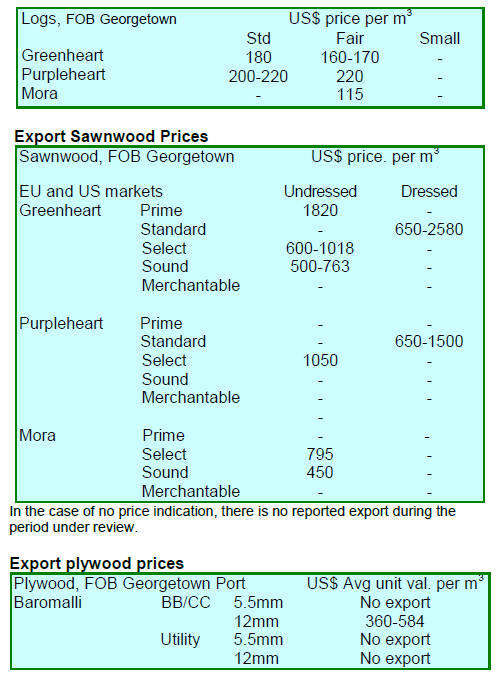2. GHANA
Value of Ghana¡¯s informal timber sector
massive
compared to exports
During a recent forum organised by the Editors Forum,
Ghana and Friends of the Earth, calls were made for action
to address the dwindling forest resources in the country.
The Forum heard that, while the forestry sector provides
employment to over a quarter of a million workers, the
security of the forest resource is at risk.
It was stated that the forest area in Ghana has
fallen from
8.6 million hectares at the beginning of this century to
below 2 million hectares today.
Mr. Kingsley Bekoe Ansah of Civic Response, a civil
society organization, stated that ¡°while timber exports
provided 10% of annual foreign exchange earnings up to
2000 this had now fallen to below 2%.
According to Mr. Ansah, the contribution of chainsaw
milling to the domestic market is estimated at over U$500
million, while formal sector timber exports provided less
than half of this.
Belgium promoted as EU import hub for Ghana
During a recent information session on business
opportunities in the country for a delegation from Belgium
and Greece led by the Flanders Investment and Trade
Agency, Peter Huyghebaert, Belgium‟s Ambassador to
Ghana, Cote d‟Ivoire and Liberia, said Belgium as an
entry hub offers an opportunity to Ghanaian exporters to
tap millions of consumers in the EU. Antwerp is the
second busiest European port.
Ghana‟s main exports to Belgium include sawnwood,
veneer sheets and plywood and a wide range of agriproducts.
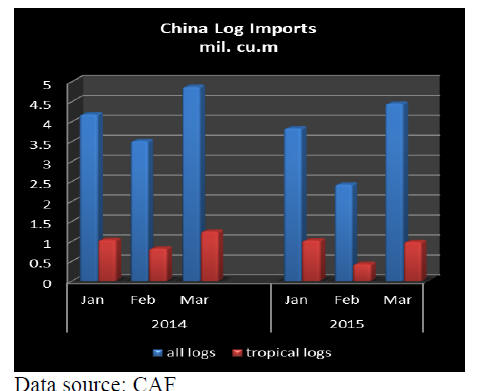

3. MALAYSIA
Focus on finished products for better
profits says
MTIB
The Malaysian Timber Industry Board (MTIB) Director
General, Dr. Jalaluddin Harun, has said wood product
exports are likely to expand to RM21 billion this year,
mainly due to more exports of processed products.
He said the MTIB will continue to promote exports of
finished products as profit margins are higher and the
markets for such products more stable than those for
commodities such as logs, sawnwood and even plywood.
In related news the MTIB wants to see an expansion of oil
palm plywood production and export to take advantage of
the abundant availability of oil palm logs.
Exports to get boost from weaker ringgit
A sustained outflow of foreign funds from Malaysia‟s
equity market drove the ringgit to a nine-year low of RM
3.80 to the US dollar, making the local currency the
region‟s second worst-performing currency after the
Indonesian rupiah.
Local economists put the ringgit‟s slide down to the
outlook for crude oil prices and the prospect of an interest
rate rise in the US but were quick to point to the positive
impact a weaker currency has on exports.
Log harvests down in first four months
In response to rising log production costs companies in
Sarawak are busy establishing plantations to ensure future
mill supplies. WTK Holdings, for example, is expanding
its forest plantation area by 12% this year and the
company plans to eventually replace natural forest logs
with plantation resources.
Log availability is a growing issue in Sarawak. In the first
four months of this year WTK harvested almost 20% less
than in the same period last year. Another timber
company, Jaya Tiasa Holdings, also reported a decline in
log production this year while Ta Ann Holdings reported a
25% decline in log production in the year to April.
It was reported that Sarawak‟s log supply fell after the
state government launched a campaign to curb illegal
logging activities and unauthorised logs exports. However,
none of the main timber companies were implicated in the
campaign.
Statistics released by the Sarawak Timber Association
(STA) show that total log production in the state for the
first four months of the year dropped by 6.2% year on
year.
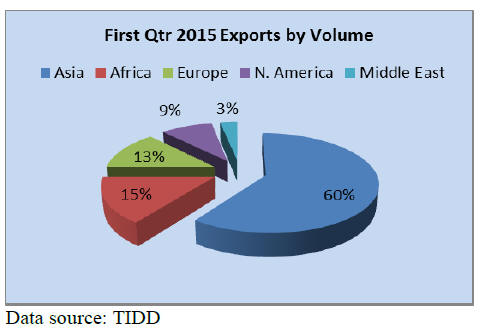
EU confident of VPA negotiations
Malaysia and the EU continue their VPA negotiations and
in late May the EU Delegation and EU's chief negotiator
organised a public consultation with Malaysian
stakeholders to share information on the VPA negotiation
process.
Stakeholders from industry, NGOs and indigenous
groups
received the latest information and discussed a wide range
of topics regarding the VPA negotiation process,
including:
• the benefits and scope of a VPA
• the role of consultations in negotiating and implementing
a VPA
• the roles of Malaysian and voluntary legality licensing
and certification schemes
• complaints procedures once the VPA is implemented
• the treatment of timber from Sarawak under the VPA
The EU expressed optimism that an agreement would be
signed with the Federal Government and also informed
that negotiations would explore clear and time-bound
commitments for Sarawak to develop its timber legality
assurance system.
For more see: http://www.euflegt.efi.int/malaysia-news/-
/asset_publisher/FWJBfN3Zu1f6/content/malaysia-andeu-
advance-vpa-process
4. INDONESIA
New forest management index
The Ministry of Environment and Forestry has launched a
forest management index for the Bali and Nusa Tenggara
ecoregions. This index provides a framework for practical
management assessments by stakeholders. The index
depicts aspects of forest monitoring, the status of forest
resources, and transparency in management law
enforcement.
Novrizal Tahar, the head of the Management Center for
Bali and Nusa Tenggara, commented that the forest
management index is a new tool for forest managers in
Indonesia.
Protected area extended
An updated map of the areas covered by the felling
moratorium has been released by the Ministry of
Environment and Forestry. The area now covered by the
moratorium has been extended and the areas covered by
the moratorium will be updated every six months.
All governors, regents and mayors across Indonesia have
been advised to refer to the latest revision before
approving land conversion or felling.
Pulp mill to source wood from plantations
Asia Pacific Resources International Holdings Ltd.
(APRIL) has announced that its subsidiary, PT Riau
Andalan Pulp and Paper (RAPP), will no longer source
raw materials from the natural forest. The company had
planned to switch to plantation resources by 2020 but has
advanced the date for the change after assessing the raw
material availability situation.
The company will now secure all of its wood raw
materials from its own plantations and those of its
suppliers.
The 480,000 hectares of plantations are sufficient
to
supply the 2.8 mil. ton capacity pulp mill according to
RAPP president Tony Wenas.
Assistance on TLAS for furniture SMEs
The Furniture and Handicraft Industry Association of
Indonesia (ASMINDO) will cooperate with FAO and the
EU FLEGT programme to help small medium sized
furniture makers satisfy the requirements of the national
timber legality assurance system (TLAS).
Indonesian furniture and handicrafts have a ready market
in the EU but recently demand has fallen. However,
despite the weaker market exports grew by around 4% as
of the end of April.
The Secretary General of ASMINDO said exports are
expected to increase by around 15% for the year as sales to
the EU are expected to pick up in the second half of the
year.
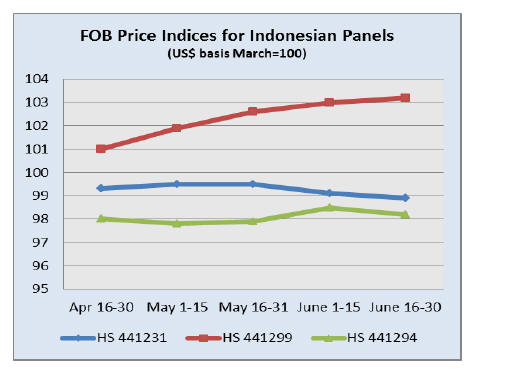
5. MYANMAR
Currency depreciation pushing up log
costs
Analyst report that mills in the country are experiencing a
weaker market but, with the continually weakening
currency, log auction prices in kyat are rising. Some
sawmillers claim they are experiencing problems in
running their mills due to rising raw material costs and
demands for higher wages.
The depreciation of the kyat is now a major factor in the
trade since the exchange rate against the dollar has fallen
from MMK 856 in Dec 2012 to MMK 983 in Dec 2013
and to MMK 1041in Dec 2014. The exchange rates on 9
Jun was MMK 1230 to the US dollar.
Teak traders are saying that market demand in Singapore,
Thailand and China has slowed considerably and similar
complaints have been heard from those trading with India.
It is likely that demand in India will remain weak for some
time as Indian stocks of teak logs purchased before the log
export ban are still substantial.
Illegal logging continues in Kachin and Shan States
The local press (Eleven media) has reported a Forest
Department statement to the effect that illegal logging has
taken a heavy toll on the ecosystem especially in the in
Kachin and Shan States.
Kachin State, Shan States and the Sagaing Division are
areas where serious timber smuggling is taking place. The
Forest Department has estimated 100,000 hoppus tons of
timber is being smuggled out annually.
Highly efficient harvesting and transportation by
smugglers and the slow progress of cooperation between
the governments of China and Myanmar is not helping the
situation say local analysts. Some 9,000 tons of timber was
seized during the first two months of this fiscal year.
MTE May tender results
The following timber was sold by Myanma Timber
Enterprise (MTE) by tender on 22 and 25 May 2015. Log
volumes are expressed in hoppus tons (H.tons) and
conversions or sawn teak (including hewn timber) are
shown in cubic tons (C.tons). Average US$ prices are
shown below.
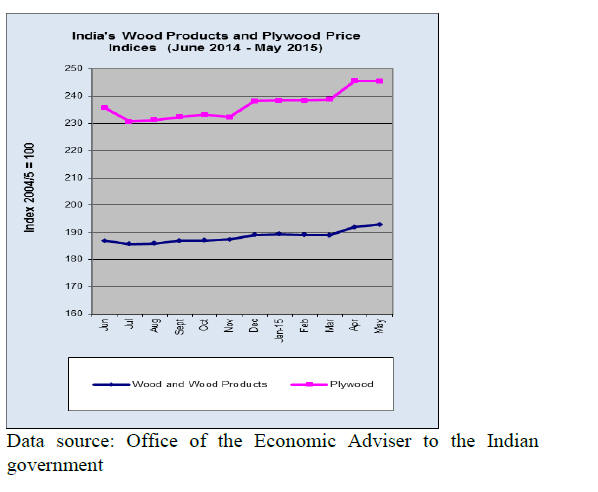
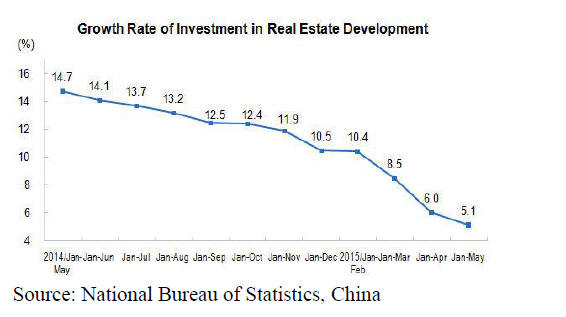
Wide price variations of concern to local
analysts
Analysts point out that there was a significant change in
the average log prices for the various grades at the recent
sale.
A sharp drop is evident in the average price of SG-4 logs
and an upward climb in the price of SG-6 and SG-7
grades. SG-2 and SG-5 prices are more or less stable. The
inconsistencies could reflect the need for log graders to
pay attention to consistency in grading.
Another issue in log pricing is the prices obtained for sales
of seized timber graded as Form-8. While the price of
Form-8 sawn teak was only about MMK 1.5million per
c.ton while Form-8 Tamalan can be about MMK 3 million
and Padauk slabs about MMK 9 million.
These timbers will be reprocessed to marketable sizes and
exported at substantially higher prices and local analysts
find the price for Form-8 logs low compared to the prices
obtained for exports.
Next MTE tender sales
MTE will conduct tender sales on 26th and 29th June. Over
ten thousand hoppus tons of non-teak hardwoods and
about 1500 hoppus tons of teak logs will be up for sale.
The quantity may be increased during the week according
to availability.
6.
INDIA
Strong growth forecast from OECD
The OECD Economic Outlook for the Indian economy
suggests growth will remain strong and stable in 2015 and
will deliver a 7.3% growth for the year. The OECD says
¡°Economic growth will remain high, supported by a
revival in investment.
The 2015-16 fiscal consolidation target has been relaxed
to allow for increased infrastructure investment while
structural reforms to improve the ease of doing business
and the Make in India initiative should boost corporate
investment. Export growth may be held back by any
currency appreciation.¡±
Infrastructure status for housing sector pushed by
MPs
Progress on the „Housing For All‟ scheme, the centrepiece
of the new Indian government‟s plan for the housing
sector, can only advance if the proposed amendment to the
Land Acquisition Act is passed according to Union
Minister for Housing and Urban Poverty Alleviation M.
Venkaiah Naidu. This would pave the way for creating 20
mil. affordable homes in urban areas by 2022.
The plan for housing has four elements namely: Slum Redevelopment,
Affordable Housing in Partnership with
Private or Public Sector, Affordable Housing through
Credit-Linked Subsidy and Subsidy for Beneficiary-led
individual house construction/enhancement.
During debate on the housing issue Indian MPs demanded
„infrastructure‟ status for the housing sector as a way to
facilitate the flow of credit to consumers, especially those
on lower income.
Illegal sawmill and plywood factories closed
During checks by the Forest Department several illegal
mills in the Yamuna Nagar district in Haryana have been
forced to shut down. In another raid 24 sawmills and 4
plywood factories in Hoshiyarpur, Punjab were closed by
the Forest Department.
In 1997 the India Supreme Court determined that
applications for investment in wood based industries must
secure approval from a Central Empowered Committee
(CEC) in the respective state. This measure was taken to
prevent illegal felling. Approval is only granted if the
investor can provide an assurance of a sustained supply of
raw material. The CEC determines the numbers and type
of machines that can be installed.
After the Supreme Court decision mills within a 10 mile
radius of government forests were forced to move and
prove they had sucure supplies before being allowed to
reopen.
Teak sales in Central India forest depots
Log auctions were held at the Jabalpur, Timarni, khirakia,
Narmada Nagar and Raipur depots of Central India and
sales were reported brisk as the quality of logs was good.
Around 5,000 cubic metres of logs were sold.
The latest ex-depot auction prices for natural forest teak
logs are shown below.
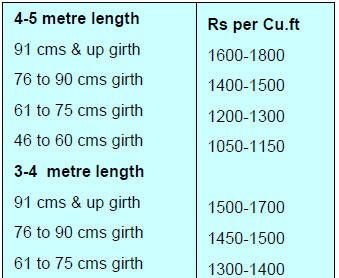
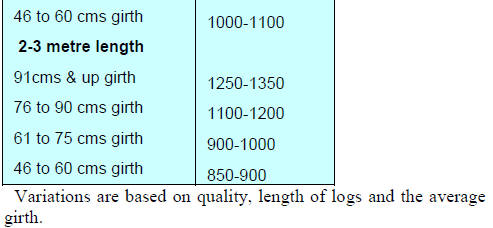
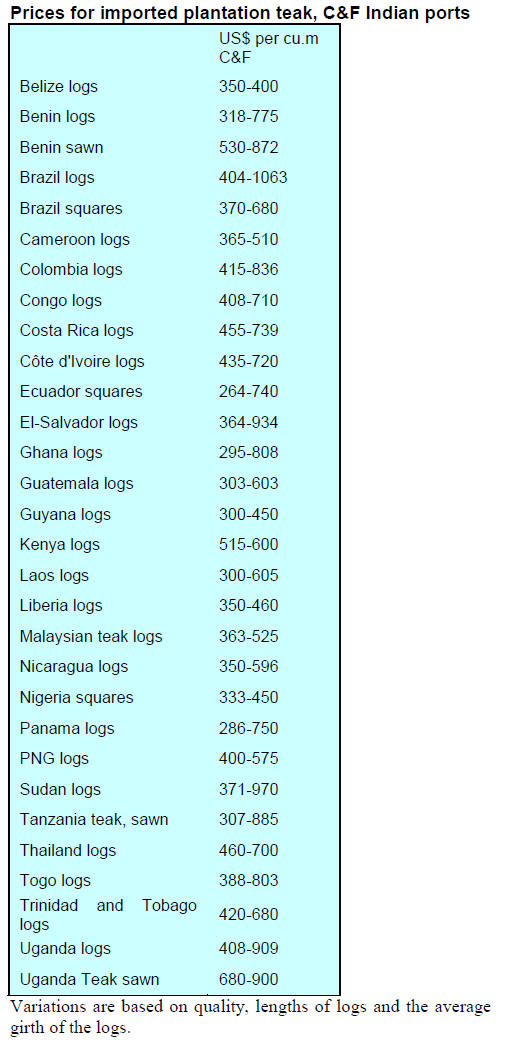
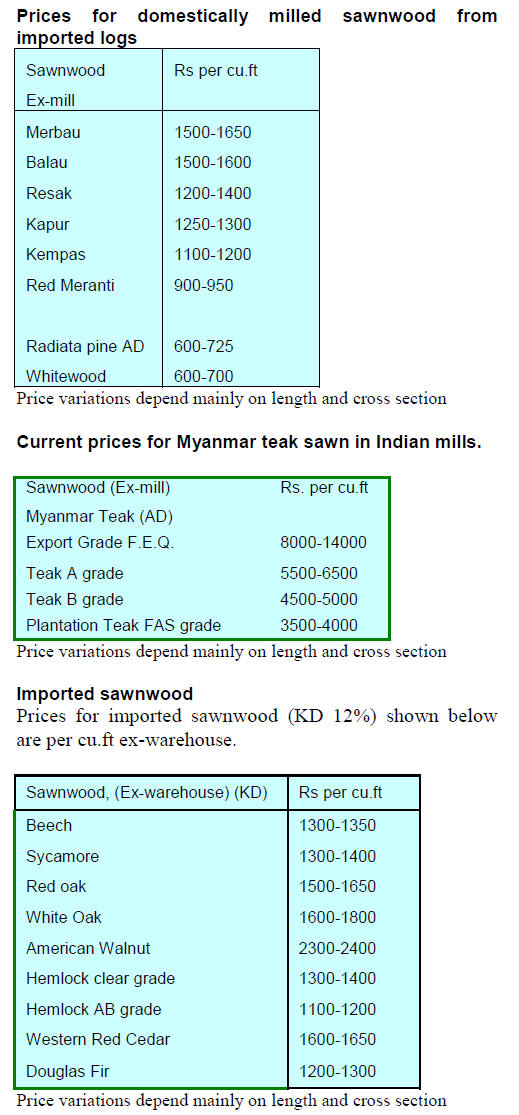
Domestic plywood prices
Analysts report the domestic demand for plywood as
„lukewarm‟ offering manufacturers no opportunity to
increase prices to compensate for rising raw material
costs.

¡¡
7.
BRAZIL
Exports increase in the first quarter
2015
The volume of Brazilian timber exports expanded 20%
between January and April this year mainly due to the
effect of the weaker currency against the US dollar and
because domestic consumption was weak.
According to the Association of Mechanically-Processed
Timber Industry (ABIMCI) recovery in US demand
helped to boost Brazilian timber exports. However,
expansion of demand in the US was not enough to sustain
overall output because domestic timber consumption fell
sharply mainly because of lower investment in
construction.
ABIMCI is working with government agencies on a plan
to stimulate timber consumption in housing and has
proposed changes to the national housing financing
scheme and technical standards to encourage the building
of wooden houses in Brazil.
APEX provides new markets for furniture exporters
The furniture export promotion project implemented by
the Brazilian Furniture Industry Association
(ABIMÓVEL) and the Brazilian Trade and Investment
Promotion Agency (APEX-Brazil) aims to promote
Brazilian furniture in international markets.
Some Brazilian companies participated in the 27th
International Contemporary Furniture Fair (ICFF) and
INDEX DUBAI in May this year.
According to ABIMÓVEL, the furniture promotion
project is an important initiative for the furniture sector
providing new business opportunities. Participation at
INDEX DUBAI generated sales estimated at US$6.5
million.
Further business missions to the United States and the
United Arab Emirates are planned as part of the export
promotion strategy.
Trade in Illegal timber of concern in Mato Grosso
The forestry sector is important for the Mato Grosso state
economy as the sector delivers employment opportunities
for around 100,000 workers and produces approx. 3
million cubic metres of roundwood annually, the second
largest log output from natural forests.
In recent years the sector has grown and between August
2012 and July 2013 (the latest period for which data are
available) the harvestable area has expanded over 50%.
However, illegal felling remains a serious problem in the
state. Researchers have detected that illegal felling in the
period August 2012 and July 2013 extended over 140,000
hectares.
It has been determined that the majority of the illegal
timber comes from areas where logging is prohibited such
as protected areas and indigenous lands.
In about 35% of the areas where uncontrolled logging
occurs there are no land titles (official land registration) or
the areas are indigenous lands which have not yet been
demarcated. Under these circumstances the state
authorities have few means to exercise control of activities
in these areas.
A certificate of origin issued by the state is required for
transport and sale of logs but researchers claim the system
is being abused as some timber producers manipulate
forest management plans inflating the area supposedly to
be logged so as to secure certificates of origin for logs
obtained outside of the legal concession.
Forest Service discusses forest concessions in
Rondônia
A delegation from the Rondônia State Secretariat for
Environmental Development (SEDAM) participated in a
meeting at the Brazilian Forest Service (SFB) to discuss
policies on forest concessions and the forest inventory in
Rondônia state.
Experiences in managing forest concessions in the Jamari
National Forest and the Jacund¨¢ National Forest (both in
Rondônia) were shared during the meeting. According to
SEDAM, Rondônia‟s forest inventory is in its final phase.
At the meeting, the utilisation of funds from the
Brazilian
Development Bank (BNDES) for monitoring, control and
forest management activities was discussed and it was
announced that R$1.52 million will be allocated to assist
SEDAM in drafting legislation and management plans.

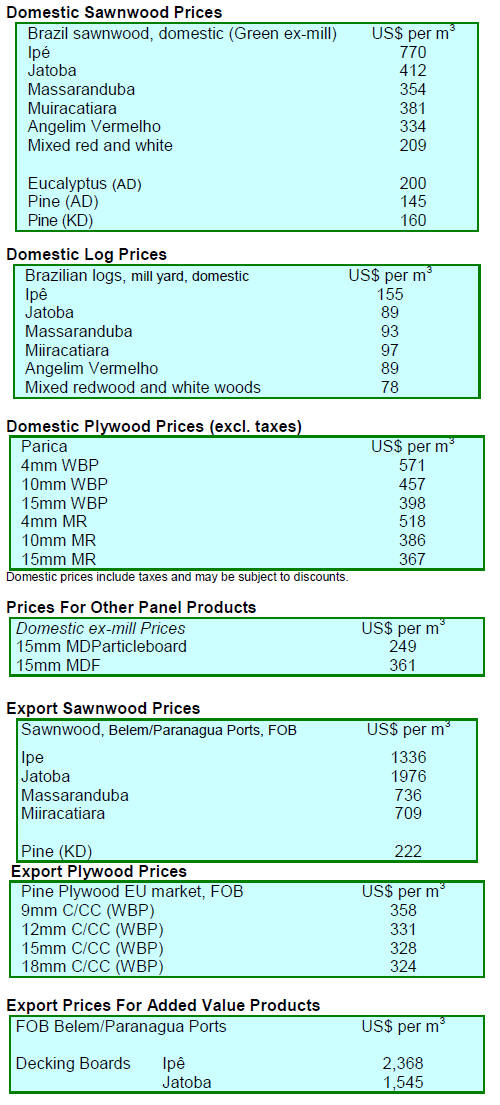
8. PERU
Multi-sectoral approach to address
hurdles to
expansion of forestry
The Minister of Production, Piero Ghezzi, said the
government is promoting the diversification of production
in the country through a multi-sectoral strategy focused on
the aquaculture and forestry sectors.
He said that technical committees have been established
within the National Productive Diversification Plan
(PNDP) to implement the startegy.
Ghezzi said the Forestry Bureau has identified many
hurdles to expansion of the forestry sector related to
inadequate regulation, cumbersome bureaucratic
processes, land titling and property registration, skilled
labour and limited access to finance all of which will be
addressed by the relevant committee.
Peruvian entrepreneurs attended Interzum Guangzhou
2015
A delegation of 23 Peruvian businessmen participated in
the fair INTERZUM- GUANGZHOU 2015. The event
took place in Guangzhou, China and is considered the
most important sector in Asia.
This was the tenth Peruvian delegation traveling to China
to participate in trade fairs and comprised of executives
representing manufacturers of furniture, machinery
importers and marketers of wood-based panels.
The delegation met with Chinese companies to examine
the technologies applied in furniture factories, to observe
distribution and sales centres and exploer business
opportunities.
In related news Peru‟s Minister of Foreign Trade and
Tourism, Magali Silva, and Thailand‟s Deputy Minister of
Commerce, Apiradi Tantraporn, recently met to advance
the signing of a Free Trade Agreement between the two
countries.
The Thai minister visited Peru with a delegation of trade
officers, representatives of private sector unions and a
group of 21 businessmen. Peru‟s exports to Thailand
include a wide variety of agricultural products.
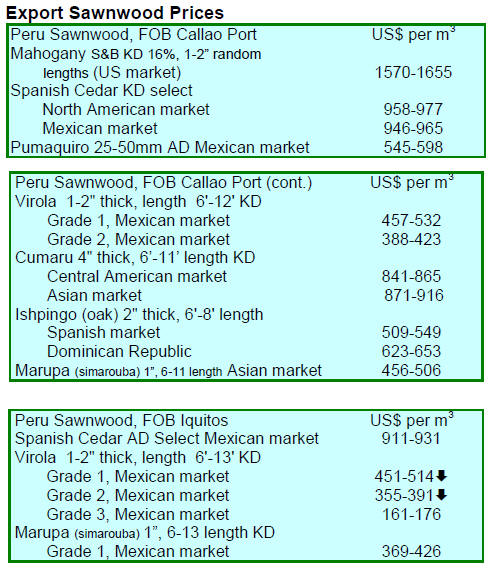
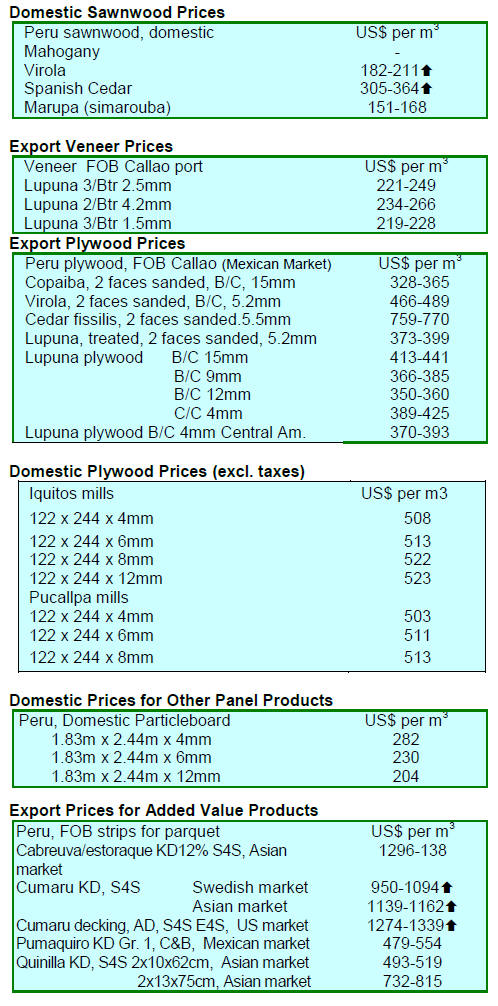
9.
GUYANA
Promoting best practices in the timber
industry
The Forest Products Development and Marketing Council
has been working to upgrade the sawmill and downstream
processing industries. Currently the focus is on a
promotional video for best practices in timber processing
in sawmill and lumberyards.
Additionally the Council continues to work with
stakeholders to improve the quality of processed forest
products for the domestic and export market through
targeted industry development initiatives and provides
appropriate market information to the stakeholders.
Export prices
There were exports of greenheart, purpleheart or mora logs
in the period reviewed.
